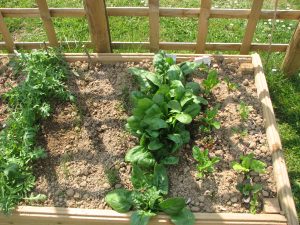There are various types of spinach you can grow, such as spinach, perpetual spinach or Swiss chard – these are all fairly easy to grow. Spinach is rich in nutrients such as iron, protein, vitamin A and chlorophyll.
Whether raw in salads or lightly steamed spinach is a suitable accompaniment to a wide range of dishes.
Soil Preparation
Spinach is a thirsty plant so prefers a moist soil – but not waterlogged. Using a mulch of grass clippings around the spinach plant will help retain the moisture levels in the soil.
Dig the soil well before growing spinach as their tap roots can grow fairly deep. When digging the soil also dig in some organic compost or manure into the soil to provide a good amount of organic matter and the nutrients for the growing season.
Spinach doesn’t like acidic soils, so check the PH of the soil after digging, the PH should be around 6.5 – 7.0. Add lime if required.
Sowing
 You can sow spinach in early spring. Make a smooth seed bed by racking the soil over. Sow the spinach seeds outside in rows 1½cm deep and try and sow the seeds about 2cm apart. Sow the rows about 20cm apart. Germination of spinach seeds can take between one to two weeks. When the spinach seedlings appear, many gardeners thin them to 10cm apart. I personally just leave them to grow as they are. To have a continuous crop of spinach over the summer you will need to stagger growing spinach over summer, you can sow spinach every two to three weeks. The last sowing should be 60 days before the first frosts in your area.
You can sow spinach in early spring. Make a smooth seed bed by racking the soil over. Sow the spinach seeds outside in rows 1½cm deep and try and sow the seeds about 2cm apart. Sow the rows about 20cm apart. Germination of spinach seeds can take between one to two weeks. When the spinach seedlings appear, many gardeners thin them to 10cm apart. I personally just leave them to grow as they are. To have a continuous crop of spinach over the summer you will need to stagger growing spinach over summer, you can sow spinach every two to three weeks. The last sowing should be 60 days before the first frosts in your area.
Growing Spinach – Position
Spinach prefers to grow in partial to full sun, though it will grow in partial shade as well.
Looking after the crop
Growing spinach is easy as long as you keep the plants well-watered when conditions are dry. Also you need to mulch around the spinach plants as this will help retain moisture in the roots.
Harvesting
Spinach is usually ready to pick around 40 to 50 days after sowing.
The spinach leaves are ready when the leaves look big enough to pick. Pick the outer leaves first so that the inner leaves are able to continue to grow – this will allow the spinach to continue cropping. Leave at least half of the spinach leaves on the plant as over-harvesting can kill the spinach plant. To reduce the leaves from wilting, cut them off as close to the base of the spinach plant as possible, it’s also better to pick the leaves in the morning or evening. The younger the spinach leaves, the tastier they are and the leaves will taste the best straight after picking.
Straight after picking put the spinach leaves into a plastic bag and place them in the fridge as soon as possible. You can store them in the fridge for a couple of days. Or you can freeze the leaves.
Varieties
Spinach has a habit of bolting that’s why many gardeners grow perpetual spinach or Swiss chard as they are hardier and don’t bolt as quickly. You can buy slow bolting spinach varieties and these take longer to blot then ordinary varieties. Spinach will bolt quicker in hot, dry days. Cooler temperatures will often result in better spinach yields.
Start growing spinach in your garden and you’ll be eating this gorgeous vegetable within 60 days.









